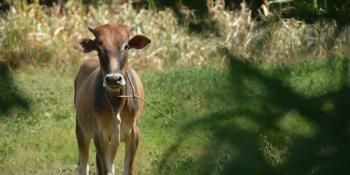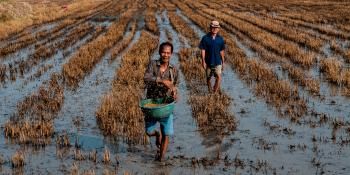Collaboration in a distributed research program: Islands of intensity in a sea of minimal interaction

What I learned about remote collaboration from 3 years at CCAFS.
I had a great time working for the CGIAR Research Program on Climate Change, Agriculture and Food Security (CCAFS) as a Knowledge Management Student Assistant and then Consultant. I loved the job and the people who I worked with. Funny enough, some of them I would only see a few times a year, some of them I never met and we would have only 2-3 hours of overlapping office hours due to time zone differences. For instance, my closest co-workers from the Knowledge and Data Sharing Team were based in Colombia, and I was sitting in our office in Denmark with a few colleagues from the Program Management Unit. But I felt that my relations and collaboration with all these people far away were going very well. So, when the time came to write my master thesis (within the area of information science and user studies), I wanted to write about something I knew and liked a lot: remote collaboration in research projects.
CCAFS Flagship 1 members were kind to participate in my little research and answered a lot of questions about how they work together, how they communicate, which tools they use, how they socialize and so on. Though it might be difficult to imagine in general, it didn’t come as a surprise to me that despite working apart they make a great team. Especially the Scenarios project that has their own microclimate; getting to know their dynamics was a real journey into deep relations supported by modern communication tools. That is why the Scenarios Team seemed like a perfect example to highlight in my thesis – only two researchers were co-located and they had well-established communication practices.
After my conversations with Marieke, Maliha, Rathana, and Lucas, the regional Scenarios Coordinators, I was very inspired and couldn’t wait to talk with their leader, Joost. The way they all talked about each other and about Joost made me wonder: who is this guy who created and leads such a fantastic team? I was about to find out during an interview that was the hardest one to schedule; and so I did. We had an amazing conversation and I thought I remembered everything he said because it was quite inspiring. So I moved forward with other tasks for my thesis, leaving the transcripts of interviews for Christmas time, a month before my deadline for submission. What a nightmare it was to find out just after opening Christmas presents that due to a technical error, not a word of what Joost said was recorded, only my questions. At this point, remote collaboration wasn’t playing to my advantage as I couldn’t just knock on Joost’s office door and highjack his lunch break for another interview; I would need to wait until February (past my deadline) to find a window for a Skype call in his busy calendar. So, I had to proceed without the interview that I imagined would be the key to the case study in my research project.
Lucky for me, Joost wasn’t the only great leader I talked to. In my analysis, I focused on the impact of the Flagship 1 Leader, Philip Thornton. One could imagine that it’s hard to manage your team members if you only see them several times or maybe only once a year. One thing that came clear across most of the interviews I had with Flagship 1 members was that Philip isn’t necessarily managing them. As one of my interviewees described it:
He is a substance leader not a power leader, he doesn’t need to play the power card ever. […] Philip is a person who has that talent and he brings that to the table, but I think it’s also coming from the top; Bruce is a similar leader, also very visionary. They don’t suffer from any lack of self-confidence or self-esteem, they know they’re worth it. They don’t need to prove themselves, it’s really not about competition, it’s about collaboration.”
Interviewee
It was also very apparent from my conversation with Philip that he respects, includes, and trusts people he works with, and probably chooses them very carefully. As he points out:
I don’t think working remotely creates a barrier. I know my team pretty well. If you don’t trust them that they will do the job, why hire them? Give people the freedom to do their job. I’d much rather do it this way than being prescriptive and telling people what to do.”
Philip Thornton, Flagship one Leader and Principal Scientist, CCAFS
This way, cooperation in the Flagship is not based on strict management, but characterized by leadership and an open line of contact. Discovering this made writing my dissertation a very fulfilling experience.
Of course, it’s not always easy to collaborate remotely. Participants of distributed projects are exposed to a risk of losing each other out of sight if they don’t have established communication practices or don’t meet often enough. From the interviews, it seemed that even if there are occasional cracks in communication, Flagship 1 members like the minimal-interaction strategy. On a daily basis, they perform their own jobs independently with a lot of passion and then they can catch up when they’re meeting in person.
Interested to know more? Read the research paper: Collaboration in a distributed research program: Islands of intensity in a sea of minimal interaction
Read more:
Magdalena Haman was the Knowledge Management Assistant at the CCAFS Program Management Unit from 2015 to 2018.



